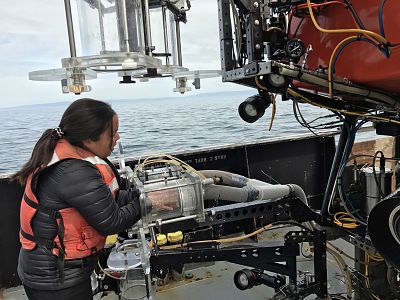At depths of 200 to 600 meters, the concentration of plastic particles was found to be roughly four times what it was near the surface.
The ocean's plastic problem goes deeper than you might have realized.
Scientists using underwater robots in the waters off California's central coast found that plastic debris has infiltrated the deep ocean, with evidence of microscopic plastic particles extending from the surface all the way to the seafloor.
"It's a longstanding question: How much plastic is in the ocean?" said Anela Choy, an assistant professor at the Scripps Institution of Oceanography at the University of California, San Diego, and lead author of the new study. "That question has mostly been answered from looking at the best available data at the surface of the ocean, but we know the ocean is a very large three-dimensional space, so we have to account for the plastic below the surface."
It's estimated that 8 million metric tons of plastic end up in the ocean each year. Choy said the study, which was conducted at two locations within the Monterey Bay National Marine Sanctuary, could account for what's known as the "missing plastic in the ocean." The term refers to the significant discrepancy that researchers have found between the total amount of plastic that has been produced and the amount of plastic that has been seen in the environment.
For their research, Choy and her colleagues used remotely operated vehicles, or ROVs, designed to sample the water at depths ranging from five to 1,000 meters. The scientists found evidence of microplastics throughout the water column, with the highest concentration of the particles seen at depths between 200 to 600 meters. The concentration at those depths was roughly four times what it was near the surface, according to Choy.
"We weren't necessarily surprised to find plastic in the deep sea, but what was surprising was that the highest concentrations were not at the surface and not at the deepest depths that we sampled, but somewhere in the middle," she said, adding that the plastic particles were also found in crabs, tadpole-like larvaceans and other marine animals that live at those depths.
The study provides further evidence that plastic is getting into marine food webs, but scientists don't yet know the implications for humans who subsequently eat the seafood.
Environment
"In the last couple of years, the [Environmental Protection Agency] has done studies to look at whether or not there's a concern for human health," Emily Woglom, executive vice president of the Washington, D.C.-based nonprofit Ocean Conservancy, said. "To date, they haven't been able to find evidence that is cause for concern, but much more research needs to be done."
Woglom added that previous research has shown ocean plastic to be a worldwide problem, but by revealing the true extent of the plastic pollution, the new research could guide more effective cleanup programs.
"There are efforts to try to skim plastic off the first couple of meters of the ocean's surface, but this study shows that it's really throughout the water column and in deeper waters," she said. "So this raises questions about if we'll be able to reach a significant portion of the plastic."
Late last year, a young Dutch inventor named Boyan Slat attempted to use a 2,000-foot-long screen deployed more than 1,000 miles off the coast of California to trap plastic debris from the surface of the ocean. But, the Ocean Cleanup device broke apart from punishing winds and waves, and the project has since been sidelined.
Choy said similar studies should be done in other bodies of water to better understand the extent of the problem and how to deal with it. She said evidence like this should serve as a wake-up call for people across the globe.
"Whether or not you live by the ocean, we're impacting that environment," Choy said. "The deep sea is so important for human society, and our work is showing that we're leaving traces of ourselves in that system."
Want more stories about the environment?
- Scientists find 414 million pieces of plastic debris on remote islands. That's even worse than it sounds.
- This floating city concept is one way to cope with climate change
- Climate change may be dissolving the ocean floor. Here's why we should be worried.
SIGN UP FOR THE MACH NEWSLETTER AND FOLLOW NBC NEWS MACH ON TWITTER, FACEBOOK, AND INSTAGRAM.












